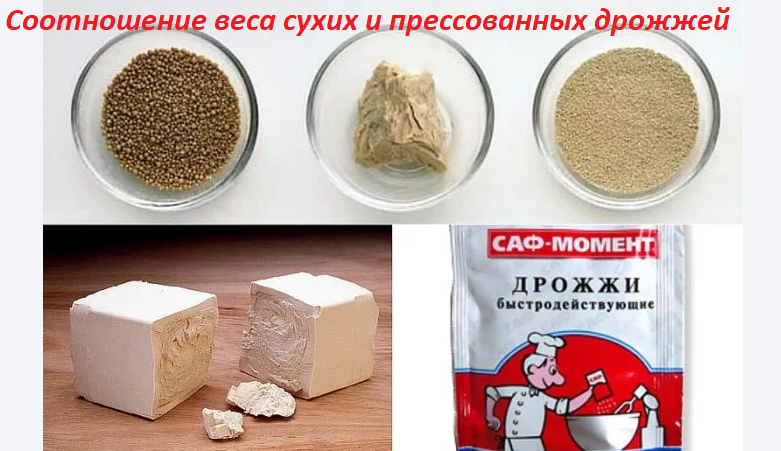Contents
- The ratio of the weight of dry and fresh (raw, wet) yeast in grams: Table
- How many dry yeast do you need 25, 50, 100 grams of fresh, ordinary?
- Replacing a teaspoon of dry with raw pressed yeast: the ratio of the weight of the yeast
- The ratio of sugar, water and yeast (dry and alcohol living): for mash moonshine
- Fresh pressed yeast and dry, flour, water: a ratio for making baking dough, the ratio of yeast in the test
- Pressed yeast and dry: mass ratio for kvass
- Video: proportion of living and dry yeast
There are several types of yeast for baking, making mash and other dishes and drinks. It often happens that dry yeast is indicated according to the recipe, and there are only pressed ones in the presence - wet. What to do in this case? This article describes the ratio of the weight of dry and raw yeast. Read further.
The ratio of the weight of dry and fresh (raw, wet) yeast in grams: Table
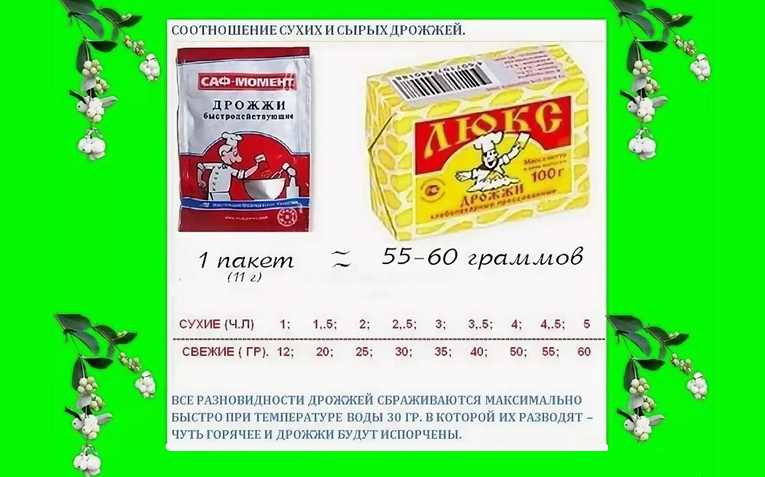
Any hostess uses leaven to prepare various dishes. But few people thought about their types and advantages. There are three varieties of yeast:
- Dry. They differ in that finished products do not have a pronounced smell. They are made by evaporation and have a granular structure - an active form and high -speed.
- Fresh (raw). Produced in the form of a compressed bar.
- Beer. They have a strong aroma and the property is poorly suitable.
Using the sourdough for different culinary masterpieces, it is possible to adjust the preparation recipe and replace their appearance. The proportions of this substitution are not known to everyone. To get the desired result, it is necessary to find out the equivalent and interchangeability of different types of yeast. For example, baking requires pressed raw yeast 3 g., And one dry one. Braga will take 600 gr. raw yeast, it will be 100 g. dry.
To find out the ratio of dry yeast to fresh, you need to multiply the weight by three. And then it turns out that 5 gr. Legislature in raw form is equivalent to one bag in dry.
Here is a table of the weight ratio of dry and fresh (raw, wet) yeast in grams:
| Dry (Ch.L.) | Fresh (gr.) |
| 1 | 10 |
| 2 | 20 |
| 3 | 30 |
| 4 | 40 |
| 5 | 50 |
These data should be taken into account while replacing the ingredients.
How many dry yeast do you need 25, 50, 100 grams of fresh, ordinary?
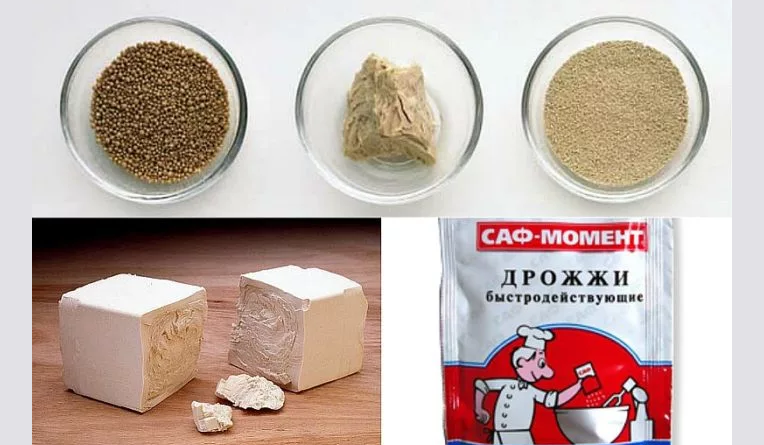
The weight of yeast mushrooms used to bake muffins is always indicated in the recipe. Sometimes there is no need for yeast at hand. Then the question arises of replacing them. How much dry yeast is needed 25, 50, 100 grams fresh, ordinary?
The proportion of interchangeability is one to three, namely 10 g There are dry ones 30 g fresh. Mathematics is simple:
- 25 gr. Fresh yeast mushrooms will be 8.5 g. dry
- 50 gr. - 15 gr. dry
- 100 gr. pressed - 33.5 gr. dry
If you understand this ratio and put into practice, you are convinced that recipes can be changed.
Important: Do not forget about the difference in active and rapidly soluble yeast. In 1 teaspoon, a dry active shape of the sourdough contains three quarters of a teaspoon of a high -tech.
Therefore, the ratio can be adjusted in this way:
- 10 gr. Active yeast product is equivalent to 25 gr. pressed
- 10 gr. The high -speed yeast product is 30 gr. in fresh (wet) form
- For 25 gr. Fresh yeast passes 10 g. active or 8 gr. Quick -acting
- At 50 gr. fresh - 20 gr. active or 17 gr. Quick -acting
- Per 100 gr. fresh - 40 gr. active or 33 gr. Quick -acting.
Depending on the factory of the manufacturer or batch of yeast, their quality may not be appropriate. Therefore, manufacturers always indicate the average ratio of yeast on packages.
Replacing a teaspoon of dry with raw pressed yeast: the ratio of the weight of the yeast
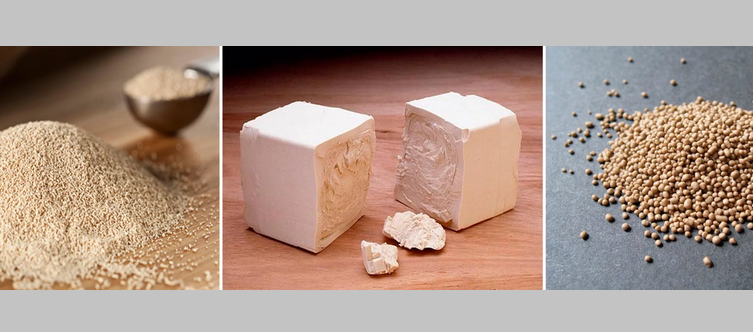
The hostess, who often bakes bread or other sdoba, knows firsthand how to replace the “living” yeast with dry ones. Below we will explain how the weight of the weight of the yeast is performed and the replacement of a teaspoon of dry ones with raw pressed yeast.
- Generally accepted and correct ratio: 1 gr. Dry is 3 gr. fresh
The manufacturer clarifies the proportionality of the products in grams on the package, depending on whether these yeast mushrooms are active or rapidly soluble.
In the kitchen, when everything is at hand, and there is no time to measure on the scales, it is always possible to use a teaspoon. What is its volume?
- If we talk about milliliters, it is considered to be its volume 5 ml.
- However, the yeast is bulk, and the volume in the spoon is three grams.
- The error is distinguished by the technique of pouring dry yeast: “with a slide” or “under a knife”. Then you can add 1-2 grams.
The recipe gives dry yeast, but are there only raw ones? Do not panic, just count:
- One gram of dry are three grams of fresh.
- AT 1 tsp. Three grams of dry yeast.
- If the recipe is indicated 2 tsp. "With a hill" of dry yeast, then the expenditure of the yeast product in cheese (wet) form for this baking will be 30 grams etc.
Often, housewives measure the ingredients with spoons, rarely use kitchen scales. At the points of sale are “living” yeast mushrooms in packages of 100 or 500 grams, and dry in packages of 7 or 11 grams.
It is worth considering: The capacity of dry yeast in one spoon is three grams, five in a spoon with a hill.
For a more accurate calculation by measurements, it was established:
- A pressed bar (like a matchbox) of a yeast product weighing 25 g. It is equal to two teaspoons of a yeast product in a dry form, one of which will be with a “slide”.
- Two such pieces, with a common weight 50 g, can be replaced 3 teaspoons With a slide of dry yeast.
- Stogram piece of fresh yeast product equivalent to three bags 11 grams dry yeast fungi in active form.
When replacing the type of yeast, one should not forget about their qualitative characteristics, depending on the terms of suitability of the product and storage conditions.
The ratio of sugar, water and yeast (dry and alcohol living): for mash moonshine
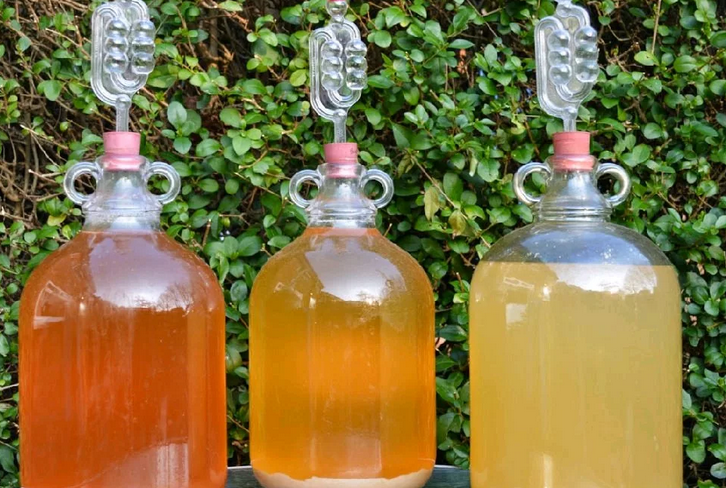
For the manufacture of mash, alcohol yeast mushrooms are used. Most often they are alive, pressed. To get high -quality distillates, it is necessary to observe production technology and use high -quality yeast. Alcohol yeast has a high fermentation rate, do not foam, resistant to alcohol and give good taste and aroma to the finished product.
What is the ratio of ingredients - sugar, water and yeast (dry and alcohol living) , suitable for making mash moonshine? Here's the answer:
There are many recipes for moonshine, but three components are taken as a basis:
- Water
- Sugar
- Alcohol yeast product
The number of yeast fungi in grams is calculated from the wort volume or relative to 1 kg of sugar.
- Ten liters of wort require 30 grams fresh pressed alcohol yeast.
- A kilogram of sugar requires 20 gr. yeast.
Recipe for high -quality mash:
Ingredients:
- 100 gr. alcohol yeast
- 20 l. bottled water
- 5 kg. Sahara
Cooking method:
- Warm water in which sugar dissolves into a large container.
- The yeast must be diluted in the part of the syrup and added to the total volume.
- Close the container and leave in a dark and warm place until the mash is ready.
Follow proportions and tips, and get a high -quality drink with a soft taste.
Fresh pressed yeast and dry, flour, water: a ratio for making baking dough, the ratio of yeast in the test
To prepare delicious and delicate pastries, it is necessary to observe the proportions of the ingredients. The main components of a butter dough are always a yeast product (in fresh pressed or dry form), sugar, water. These ingredients are correlated with the number of flour.
- The share of fresh (wet) yeast product in relation to flour for the preparation of a test workpiece for baking should be from 2 to 5 percent. It all depends on the finished product.
- It means that 1 kilogram Flour is necessary 20-50 grams fresh yeast product.
- In terms of dry yeast, this means about 10 grams.
Therefore, the share of dry yeast in relation to one kilogram of flour is from one to one and a half percent. Often this ratio for the test is indicated on the package with yeast.
- As for the liquid, it is usually added 2.5 times lessthan flour.
- But this proportion is conditional, since it all depends on the qualitative indicators of the flour and the number of other liquid ingredients (eggs, oil).
Thus, knowing the ratio of products, you can make an approximate recipe for a concrete dough, which will be the basis for various variations.
Pressed yeast and dry: mass ratio for kvass
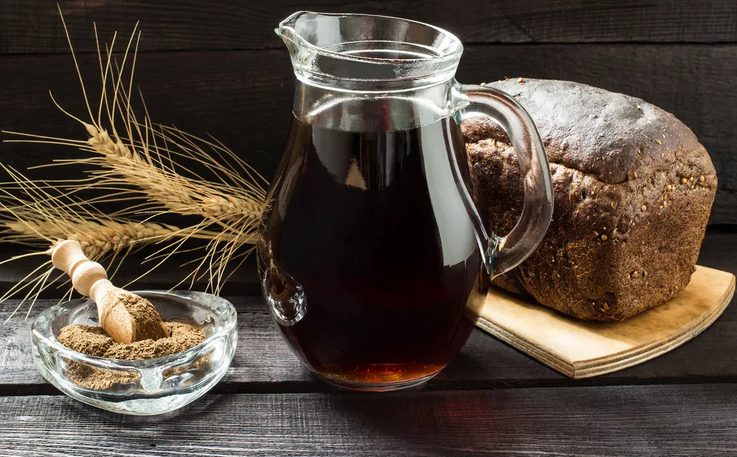
Thanks to the yeast, not only delicious butter baking is obtained, but, for example, kvass. This drink is popular and loved by everyone. Previously, a raw pressed yeast product was used for its preparation. Today, knowing the correct proportion, you can replace them with dry. Since this species is most convenient to use. Here is the recipe and mass ratio for kvass:
Prepare kvass in different ways:
- With black Borodinsky bread
- Kvassian worship
In both cases, you can use different types of yeast product. Speaking about the ratio of the mass of yeast for your favorite drink, it should be noted that the calculation is carried out for three liters of water.
The three -liter jar needs:
- Several slices of bread
- One and a half glass of sugar
- Teaspoon of dry yeast
Ten grams are taken compressed yeast, but if a wort is used in the recipe, then their weight can be halved. Accordingly, dry yeast can be put 3 times less-3-4 grams.
Now you know how to add dry and fresh yeast. Bake delicious sdoba, make kvass, mash and other dishes and drinks. Thanks to the correct proportions, they will turn out tasty. Good luck!

